warning light MITSUBISHI GRANDIS 2008 (in English) User Guide
[x] Cancel search | Manufacturer: MITSUBISHI, Model Year: 2008, Model line: GRANDIS, Model: MITSUBISHI GRANDIS 2008Pages: 458, PDF Size: 18.52 MB
Page 235 of 458
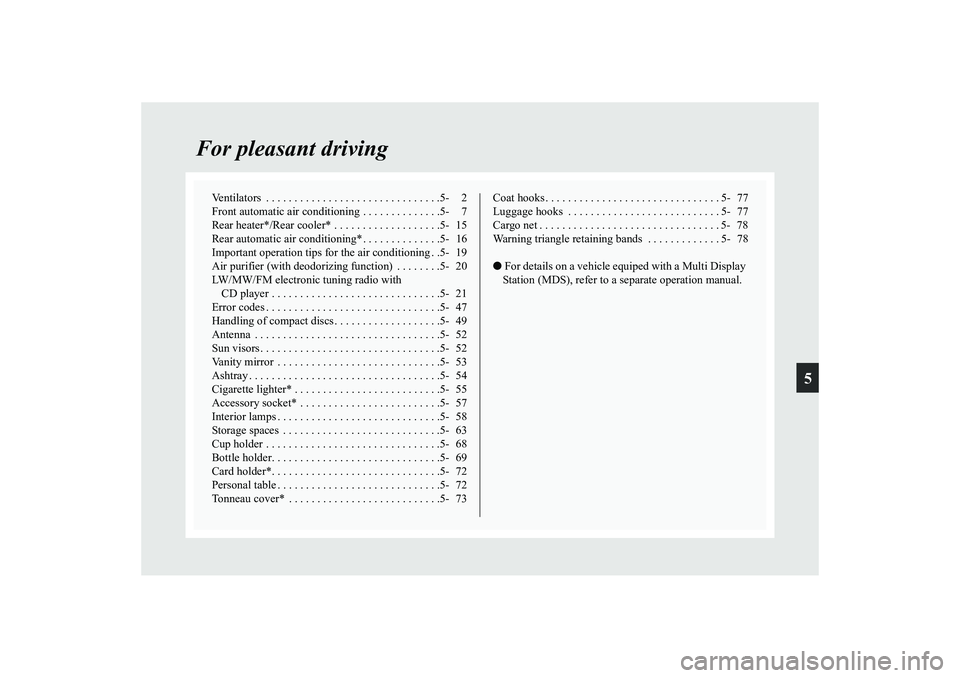
5
For pleasant driving
Ventilators . . . . . . . . . . . . . . . . . . . . . . . . . . . . . . .5- 2
Front automatic air conditioning . . . . . . . . . . . . . .5- 7
Rear heater*/Rear cooler* . . . . . . . . . . . . . . . . . . .5- 15
Rear automatic air conditioning* . . . . . . . . . . . . . .5- 16
Important operation tips for the air conditioning . .5- 19
Air purifier (with deodorizing function) . . . . . . . .5- 20
LW/MW/FM electronic tuning radio with
CD player . . . . . . . . . . . . . . . . . . . . . . . . . . . . . .5- 21
Error codes . . . . . . . . . . . . . . . . . . . . . . . . . . . . . . .5- 47
Handling of compact discs . . . . . . . . . . . . . . . . . . .5- 49
Antenna . . . . . . . . . . . . . . . . . . . . . . . . . . . . . . . . .5- 52
Sun visors . . . . . . . . . . . . . . . . . . . . . . . . . . . . . . . .5- 52
Vanity mirror . . . . . . . . . . . . . . . . . . . . . . . . . . . . .5- 53
Ashtray . . . . . . . . . . . . . . . . . . . . . . . . . . . . . . . . . .5- 54
Cigarette lighter* . . . . . . . . . . . . . . . . . . . . . . . . . .5- 55
Accessory socket* . . . . . . . . . . . . . . . . . . . . . . . . .5- 57
Interior lamps . . . . . . . . . . . . . . . . . . . . . . . . . . . . .5- 58
Storage spaces . . . . . . . . . . . . . . . . . . . . . . . . . . . .5- 63
Cup holder . . . . . . . . . . . . . . . . . . . . . . . . . . . . . . .5- 68
Bottle holder. . . . . . . . . . . . . . . . . . . . . . . . . . . . . .5- 69
Card holder*. . . . . . . . . . . . . . . . . . . . . . . . . . . . . .5- 72
Personal table . . . . . . . . . . . . . . . . . . . . . . . . . . . . .5- 72
Tonneau cover* . . . . . . . . . . . . . . . . . . . . . . . . . . .5- 73Coat hooks . . . . . . . . . . . . . . . . . . . . . . . . . . . . . . . 5- 77
Luggage hooks . . . . . . . . . . . . . . . . . . . . . . . . . . . 5- 77
Cargo net . . . . . . . . . . . . . . . . . . . . . . . . . . . . . . . . 5- 78
Warning triangle retaining bands . . . . . . . . . . . . . 5- 78
● For details on a vehicle equiped with a Multi Display
Station (MDS), refer to a separate operation manual.
BK-XP08E1ENUK.en-uk.book Page 1 Monday, August 13, 2007 2:20 PM
Page 312 of 458
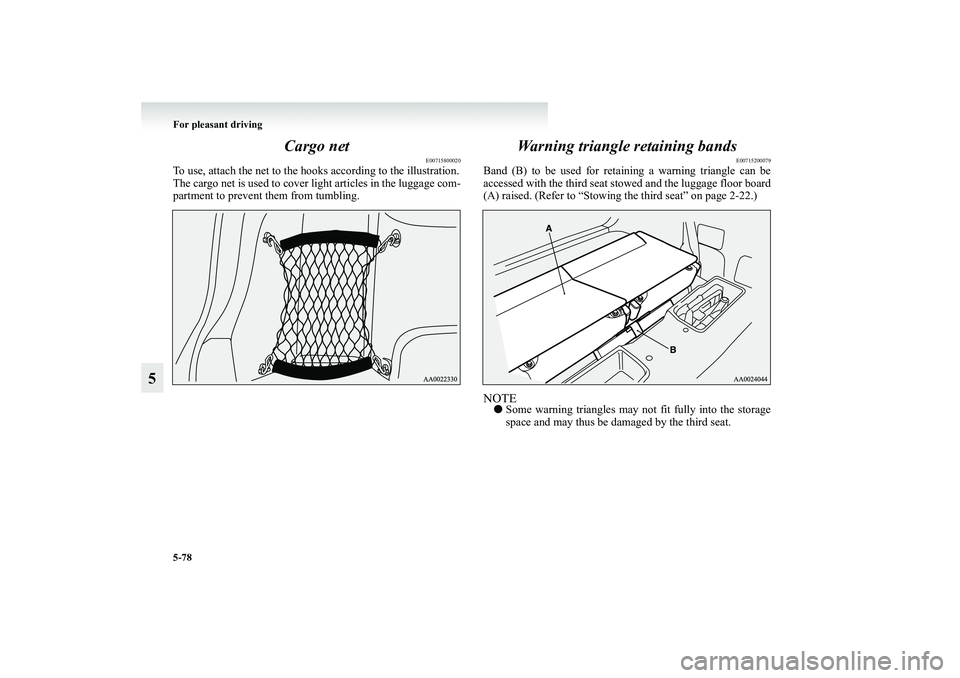
5-78 For pleasant driving
5Cargo net
E00715800020
To use, attach the net to the hooks according to the illustration.
The cargo net is used to cover light articles in the luggage com-
partment to prevent them from tumbling.
Warning triangle retaining bands
E00715200079
Band (B) to be used for retaining a warning triangle can be
accessed with the third seat stowed and the luggage floor board
(A) raised. (Refer to “Stowing the third seat” on page 2-22.)NOTE●Some warning triangles may not fit fully into the storage
space and may thus be damaged by the third seat.
BK-XP08E1ENUK.en-uk.book Page 78 Monday, August 13, 2007 2:20 PM
Page 327 of 458

For emergencies
6-15
6
9. Insert the bar (F) into the wheel nut wrench (G). Then put
the end of the bar into the shaft’s jack end, as shown in the
illustration.
Slowly rotate the wheel nut wrench until the tyre is raised
slightly off the ground surface.
WARNING
!●Stop jacking up the vehicle as soon as the tyre is
raised off the ground. It is dangerous to raise the
vehicle any higher.●Do not get under your vehicle while using the jack.●Do not bump the raised vehicle or leave it sitting on
the jack for a long time. Both are very dangerous.●Do not use a jack except the one that came with your
vehicle.●The jack should not be used for any purpose other
than to change a tyre.
●No one should be in your vehicle when using the
jack.●Do not start or run the engine while your vehicle is
on the jack.●Do not turn the raised wheel. The tyres still on the
ground could turn and make your vehicle fall off the
jack.
WARNING
!
BK-XP08E1ENUK.en-uk.book Page 15 Monday, August 13, 2007 2:20 PM
Page 335 of 458
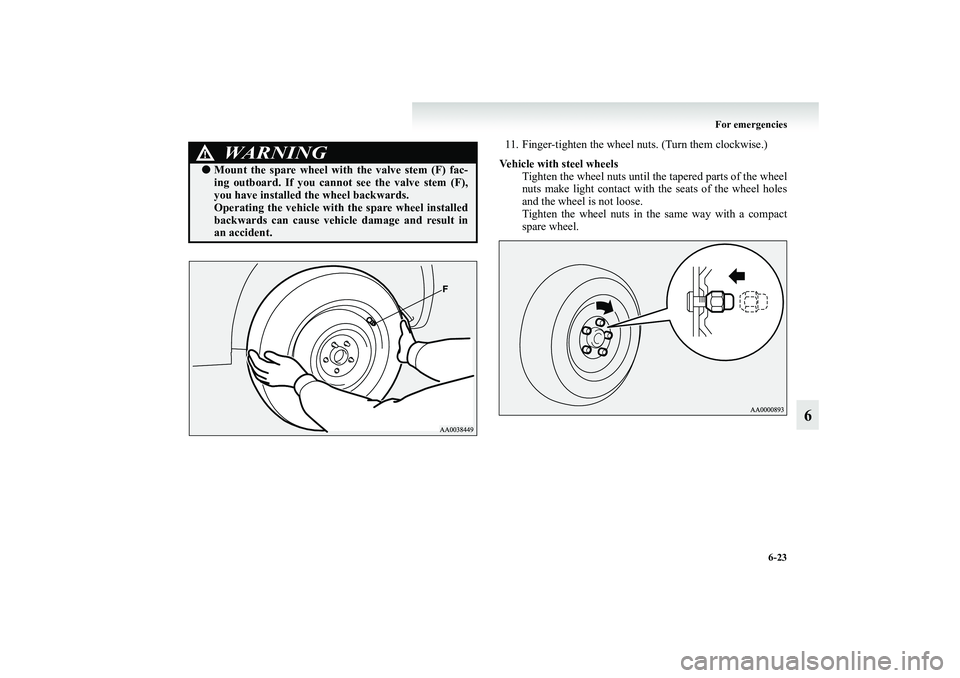
For emergencies
6-23
6
11. Finger-tighten the wheel nuts. (Turn them clockwise.)
Vehicle with steel wheels
Tighten the wheel nuts until the tapered parts of the wheel
nuts make light contact with the seats of the wheel holes
and the wheel is not loose.
Tighten the wheel nuts in the same way with a compact
spare wheel.
WARNING
!●Mount the spare wheel with the valve stem (F) fac-
ing outboard. If you cannot see the valve stem (F),
you have installed the wheel backwards.
Operating the vehicle with the spare wheel installed
backwards can cause vehicle damage and result in
an accident.
BK-XP08E1ENUK.en-uk.book Page 23 Monday, August 13, 2007 2:20 PM
Page 347 of 458
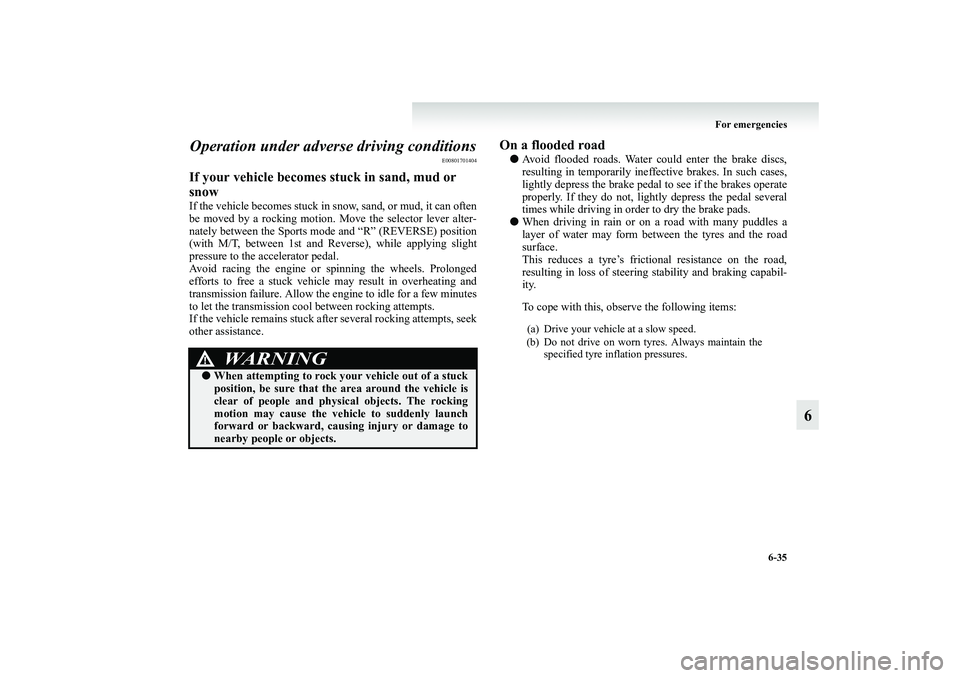
For emergencies
6-35
6 Operation under adverse driving conditions
E00801701404
If your vehicle becomes stuck in sand, mud or
snowIf the vehicle becomes stuck in snow, sand, or mud, it can often
be moved by a rocking motion. Move the selector lever alter-
nately between the Sports mode and “R” (REVERSE) position
(with M/T, between 1st and Reverse), while applying slight
pressure to the accelerator pedal.
Avoid racing the engine or spinning the wheels. Prolonged
efforts to free a stuck vehicle may result in overheating and
transmission failure. Allow the engine to idle for a few minutes
to let the transmission cool between rocking attempts.
If the vehicle remains stuck after several rocking attempts, seek
other assistance.
On a flooded road●Avoid flooded roads. Water could enter the brake discs,
resulting in temporarily ineffective brakes. In such cases,
lightly depress the brake pedal to see if the brakes operate
properly. If they do not, lightly depress the pedal several
times while driving in order to dry the brake pads.
●When driving in rain or on a road with many puddles a
layer of water may form between the tyres and the road
surface.
This reduces a tyre’s frictional resistance on the road,
resulting in loss of steering stability and braking capabil-
ity.
To cope with this, observe the following items:
WARNING
!●When attempting to rock your vehicle out of a stuck
position, be sure that the area around the vehicle is
clear of people and physical objects. The rocking
motion may cause the vehicle to suddenly launch
forward or backward, causing injury or damage to
nearby people or objects.
(a) Drive your vehicle at a slow speed.
(b) Do not drive on worn tyres. Always maintain the
specified tyre inflation pressures.
BK-XP08E1ENUK.en-uk.book Page 35 Monday, August 13, 2007 2:20 PM
Page 366 of 458
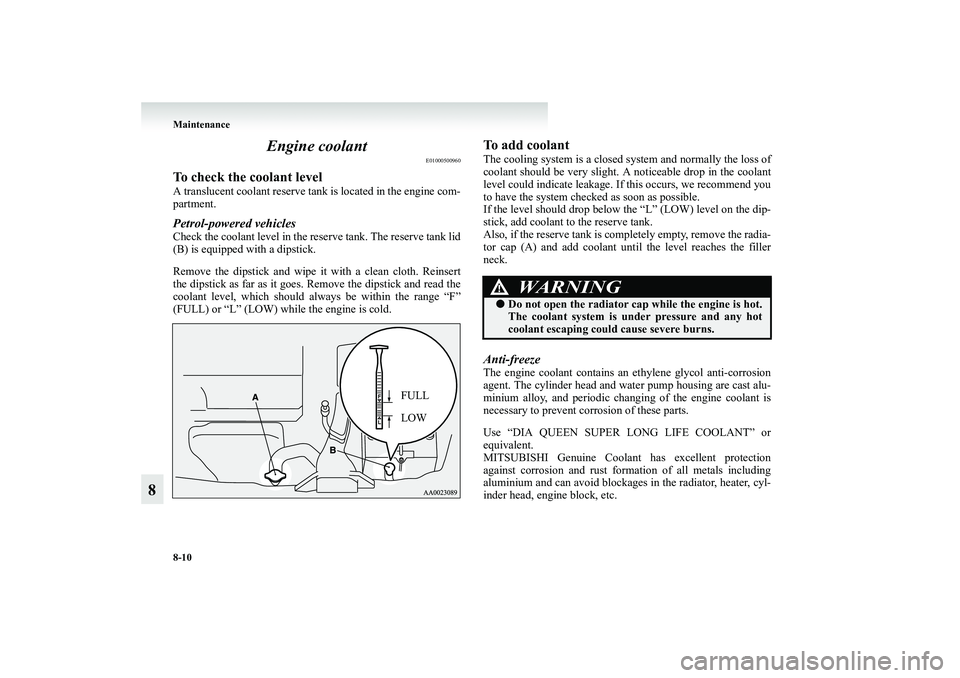
8-10 Maintenance
8Engine coolant
E01000500960
To check the coolant levelA translucent coolant reserve tank is located in the engine com-
partment.Petrol-powered vehiclesCheck the coolant level in the reserve tank. The reserve tank lid
(B) is equipped with a dipstick.
Remove the dipstick and wipe it with a clean cloth. Reinsert
the dipstick as far as it goes. Remove the dipstick and read the
coolant level, which should always be within the range “F”
(FULL) or “L” (LOW) while the engine is cold.
To add coolantThe cooling system is a closed system and normally the loss of
coolant should be very slight. A noticeable drop in the coolant
level could indicate leakage. If this occurs, we recommend you
to have the system checked as soon as possible.
If the level should drop below the “L” (LOW) level on the dip-
stick, add coolant to the reserve tank.
Also, if the reserve tank is completely empty, remove the radia-
tor cap (A) and add coolant until the level reaches the filler
neck.Anti-freezeThe engine coolant contains an ethylene glycol anti-corrosion
agent. The cylinder head and water pump housing are cast alu-
minium alloy, and periodic changing of the engine coolant is
necessary to prevent corrosion of these parts.
Use “DIA QUEEN SUPER LONG LIFE COOLANT” or
equivalent.
MITSUBISHI Genuine Coolant has excellent protection
against corrosion and rust formation of all metals including
aluminium and can avoid blockages in the radiator, heater, cyl-
inder head, engine block, etc.
FULL
LOW
WARNING
!●Do not open the radiator cap while the engine is hot.
The coolant system is under pressure and any hot
coolant escaping could cause severe burns.
BK-XP08E1ENUK.en-uk.book Page 10 Monday, August 13, 2007 2:20 PM
Page 368 of 458
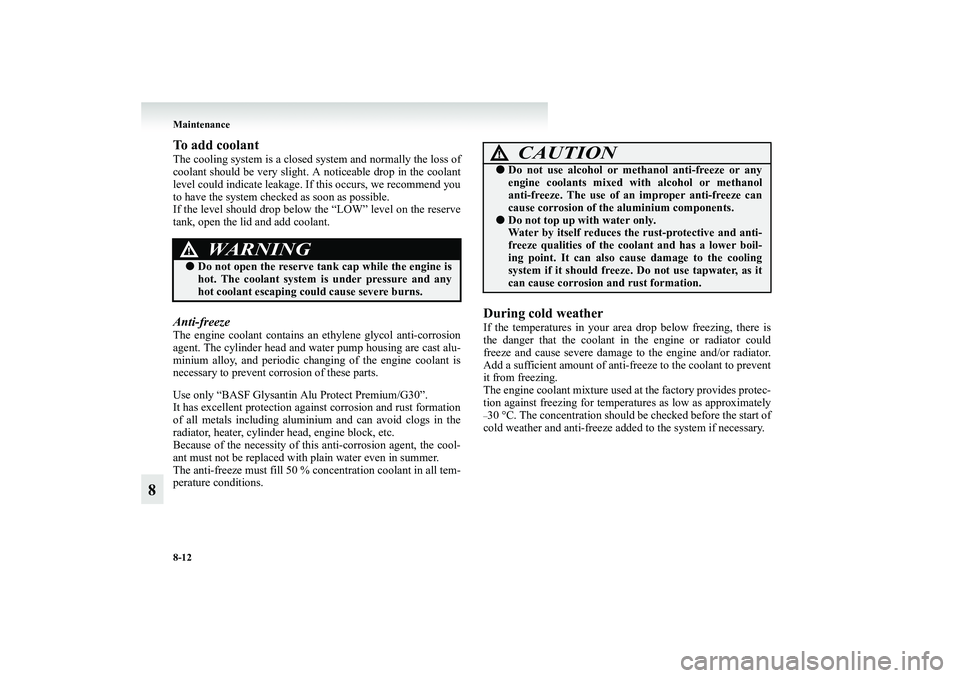
8-12 Maintenance
8
To add coolantThe cooling system is a closed system and normally the loss of
coolant should be very slight. A noticeable drop in the coolant
level could indicate leakage. If this occurs, we recommend you
to have the system checked as soon as possible.
If the level should drop below the “LOW” level on the reserve
tank, open the lid and add coolant.Anti-freezeThe engine coolant contains an ethylene glycol anti-corrosion
agent. The cylinder head and water pump housing are cast alu-
minium alloy, and periodic changing of the engine coolant is
necessary to prevent corrosion of these parts.
Use only “BASF Glysantin Alu Protect Premium/G30”.
It has excellent protection against corrosion and rust formation
of all metals including aluminium and can avoid clogs in the
radiator, heater, cylinder head, engine block, etc.
Because of the necessity of this anti-corrosion agent, the cool-
ant must not be replaced with plain water even in summer.
The anti-freeze must fill 50 % concentration coolant in all tem-
perature conditions.
During cold weatherIf the temperatures in your area drop below freezing, there is
the danger that the coolant in the engine or radiator could
freeze and cause severe damage to the engine and/or radiator.
Add a sufficient amount of anti-freeze to the coolant to prevent
it from freezing.
The engine coolant mixture used at the factory provides protec-
tion against freezing for temperatures as low as approximately–30 °C. The concentration should be checked before the start of
cold weather and anti-freeze added to the system if necessary.
WARNING
!●Do not open the reserve tank cap while the engine is
hot. The coolant system is under pressure and any
hot coolant escaping could cause severe burns.
CAUTION
!●Do not use alcohol or methanol anti-freeze or any
engine coolants mixed with alcohol or methanol
anti-freeze. The use of an improper anti-freeze can
cause corrosion of the aluminium components.●Do not top up with water only.
Water by itself reduces the rust-protective and anti-
freeze qualities of the coolant and has a lower boil-
ing point. It can also cause damage to the cooling
system if it should freeze. Do not use tapwater, as it
can cause corrosion and rust formation.
BK-XP08E1ENUK.en-uk.book Page 12 Monday, August 13, 2007 2:20 PM
Page 370 of 458
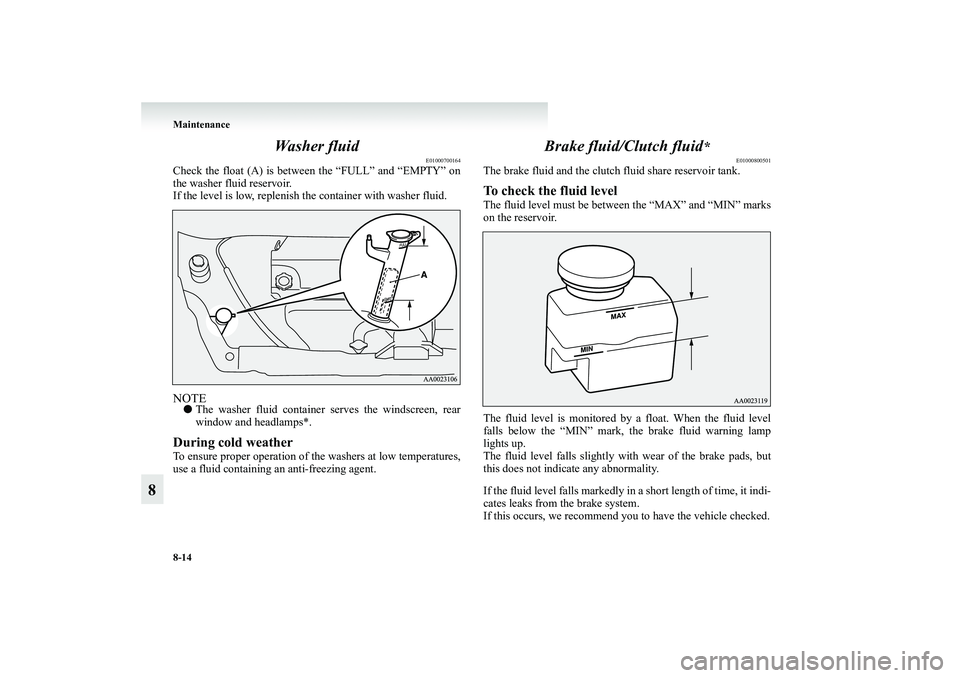
8-14 Maintenance
8Wa s h e r f l u i d
E01000700164
Check the float (A) is between the “FULL” and “EMPTY” on
the washer fluid reservoir.
If the level is low, replenish the container with washer fluid.NOTE●The washer fluid container serves the windscreen, rear
window and headlamps*.During cold weather To ensure proper operation of the washers at low temperatures,
use a fluid containing an anti-freezing agent.
Brake fluid/Clutch fluid
*
E01000800501
The brake fluid and the clutch fluid share reservoir tank.To check the fluid levelThe fluid level must be between the “MAX” and “MIN” marks
on the reservoir.
The fluid level is monitored by a float. When the fluid level
falls below the “MIN” mark, the brake fluid warning lamp
lights up.
The fluid level falls slightly with wear of the brake pads, but
this does not indicate any abnormality.
If the fluid level falls markedly in a short length of time, it indi-
cates leaks from the brake system.
If this occurs, we recommend you to have the vehicle checked.
BK-XP08E1ENUK.en-uk.book Page 14 Monday, August 13, 2007 2:20 PM
Page 442 of 458
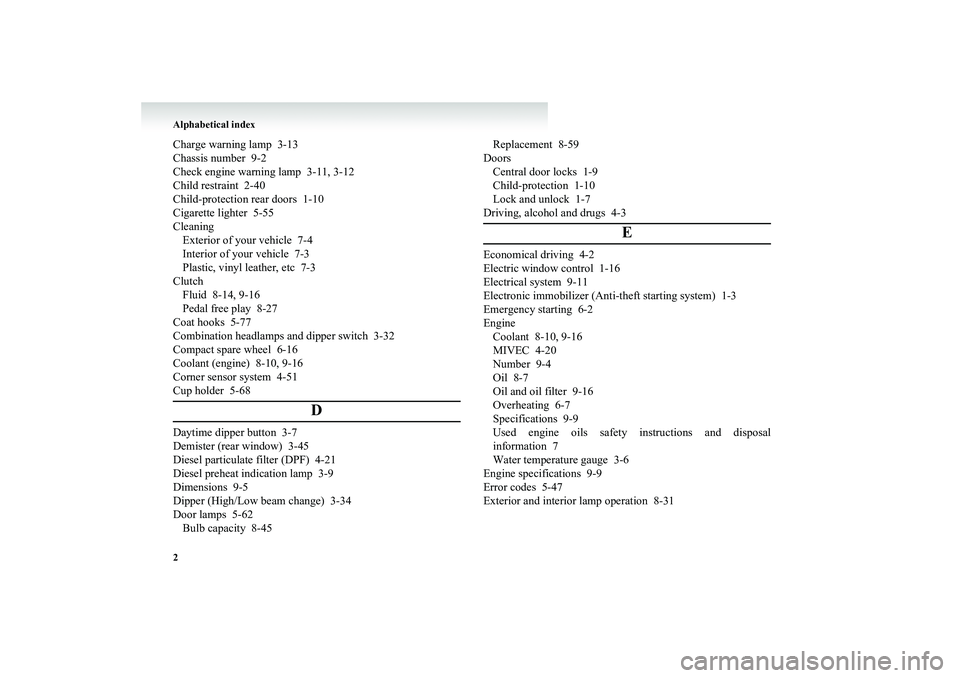
Alphabetical index
2Charge warning lamp 3-13
Chassis number 9-2
Check engine warning lamp 3-11, 3-12
Child restraint 2-40
Child-protection rear doors 1-10
Cigarette lighter 5-55
Cleaning
Exterior of your vehicle 7-4
Interior of your vehicle 7-3
Plastic, vinyl leather, etc 7-3
Clutch
Fluid 8-14, 9-16
Pedal free play 8-27
Coat hooks 5-77
Combination headlamps and dipper switch 3-32
Compact spare wheel 6-16
Coolant (engine) 8-10, 9-16
Corner sensor system 4-51
Cup holder 5-68
D
Daytime dipper button 3-7
Demister (rear window) 3-45
Diesel particulate filter (DPF) 4-21
Diesel preheat indication lamp 3-9
Dimensions 9-5
Dipper (High/Low beam change) 3-34
Door lamps 5-62
Bulb capacity 8-45Replacement 8-59
Doors
Central door locks 1-9
Child-protection 1-10
Lock and unlock 1-7
Driving, alcohol and drugs 4-3
E
Economical driving 4-2
Electric window control 1-16
Electrical system 9-11
Electronic immobilizer (Anti-theft starting system) 1-3
Emergency starting 6-2
Engine
Coolant 8-10, 9-16
MIVEC 4-20
Number 9-4
Oil 8-7
Oil and oil filter 9-16
Overheating 6-7
Specifications 9-9
Used engine oils safety instructions and disposal
information 7
Water temperature gauge 3-6
Engine specifications 9-9
Error codes 5-47
Exterior and interior lamp operation 8-31
BK-XP08E1ENUK.en-uk.book Page 2 Monday, August 13, 2007 2:20 PM